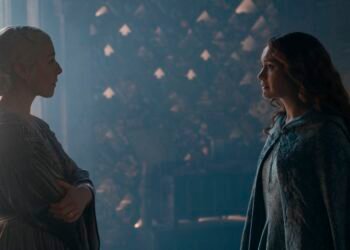It isn’t apparent exactly what writer-directors Elle-Máijá Tailfeathers and Kathleen Hepburn did to make their Netflix film The Body Remembers When the World Broke Open so tense and real until the story is well underway. Released on Netflix by Ava DuVernay’s distribution company, ARRAY Releasing, it’s one of the most impressive titles to hit the streaming platform this year. The story is told in real time, but after the first scenes, it’s edited to appear as a single-take story, and the tension of waiting for a cut or a respite feels like a held breath.
Tailfeathers and Violet Nelson star as Áila and Rosie, two First Nations women muddling through a difficult couple of hours after Áila finds Rosie standing in the middle of the street, barefoot and bruised. A short distance away, Rosie’s boyfriend continues to scream at her, but does not come closer or intervene as Áila leads her away.
The rapport between the two women is uneasy, not just because they’re strangers, but because they seem to be complete opposites. Áila leads a comfortable, stable middle-class existence, and has just been fitted for an IUD. (She’s decided she doesn’t want to have children, even though her boyfriend does.) Rosie lives with her boyfriend and his mother, has no local support system, and is heavily pregnant. Subtler differences make themselves known as the movie progresses, as when Rosie notes that even though they’re both First Nations, Áila looks much whiter.

It’s harder for them to articulate the bond they still share as Indigenous women about to make big changes in relation to motherhood. Though they often fight — Rosie accuses Áila of looking down on her and thinking she knows better, while Áila grows frustrated with Rosie’s unwillingness to open up and her temptation to slide back into bad habits — they still hang onto each other.
Shot on 16mm by cinematographer Norm Li, the film keeps its seams invisible. (Long takes were stitched together to achieve the continuous effect.) It’s the second stitched-together single-shot film to be released this holiday season, but unlike Sam Mendes’ 1917, it hasn’t been sold around that point. Here, the one-take effect is a means to an end, rather than the end itself. The one-shot style builds the sense that viewers are actively present and participating in the story, rather than simply observing it. The camera’s movements to accommodate Áila and Rosie’s movements in a small apartment, or getting in and out of a car, feel like the audience’s own, but they’re deft enough to keep the maneuvering from feeling obvious.
Tailfeathers and Hepburn up that sense of verisimilitude by letting scenes play out naturally. Setting the film in real time means silences and awkward gaps are left as-is, rather than being cut for the sake of action or flow. (Early on, Rosie even digs at Áila for being too chatty.) The Body Remembers When the World Broke Open primarily finds its drama in the shifting emotions, that is, in territory that’s best shown rather than told. Trying to help someone escape domestic abuse when they aren’t willing to leave is difficult. And the long, silent car ride where Rosie makes up her mind, while Áila struggles with the fact that she can’t ultimately make Rosie’s choices for her, is all the more effective for being a single piece. It doesn’t need to be cut or over-edited to convey a sense of urgency.

Their revelations are unforced and almost feel entirely unscripted, especially since Áila and Rosie are generally the only significant presences on screen. Even when other characters are introduced — the cab driver who takes Áila and Rosie to a safehouse, the administrators there — the camera is chiefly on the two women. The lack of breaks means their conversations are often filmed with a focus on one of them or the other, allowing the audience to better track the shifts in a single character’s emotions and properly invest. There isn’t even any music, besides what Rosie and Áila choose to listen to themselves.
As simple as the film is, The Body Remembers When the World Broke Open is tremendously affecting for how well it’s acted, edited, and filmed. The one-take style isn’t just a gimmick; it serves a purpose, inexorably pulling viewers into the story. Rosie and Áila share just under two hours together, and yet their final parting is wrenching, thanks to how well Tailfeathers and Hepburn handle the heavy material. There’s no way of knowing whether these women will be all right, or whether they’ll ever meet again. But the film opens the door to let the audience wonder, making the story feel much bigger than it is.
The Body Remembers When the World Broke Open is streaming on Netflix now.
















































